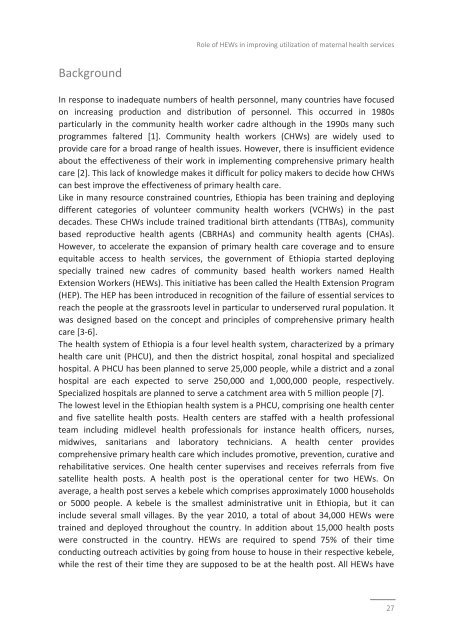araya-thesis
araya-thesis
araya-thesis
Create successful ePaper yourself
Turn your PDF publications into a flip-book with our unique Google optimized e-Paper software.
Role of HEWs in improving utilization of maternal health services<br />
Background<br />
In response to inadequate numbers of health personnel, many countries have focused<br />
on increasing production and distribution of personnel. This occurred in 1980s<br />
particularly in the community health worker cadre although in the 1990s many such<br />
programmes faltered [1]. Community health workers (CHWs) are widely used to<br />
provide care for a broad range of health issues. However, there is insufficient evidence<br />
about the effectiveness of their work in implementing comprehensive primary health<br />
care [2]. This lack of knowledge makes it difficult for policy makers to decide how CHWs<br />
can best improve the effectiveness of primary health care.<br />
Like in many resource constrained countries, Ethiopia has been training and deploying<br />
different categories of volunteer community health workers (VCHWs) in the past<br />
decades. These CHWs include trained traditional birth attendants (TTBAs), community<br />
based reproductive health agents (CBRHAs) and community health agents (CHAs).<br />
However, to accelerate the expansion of primary health care coverage and to ensure<br />
equitable access to health services, the government of Ethiopia started deploying<br />
specially trained new cadres of community based health workers named Health<br />
Extension Workers (HEWs). This initiative has been called the Health Extension Program<br />
(HEP). The HEP has been introduced in recognition of the failure of essential services to<br />
reach the people at the grassroots level in particular to underserved rural population. It<br />
was designed based on the concept and principles of comprehensive primary health<br />
care [3‐6].<br />
The health system of Ethiopia is a four level health system, characterized by a primary<br />
health care unit (PHCU), and then the district hospital, zonal hospital and specialized<br />
hospital. A PHCU has been planned to serve 25,000 people, while a district and a zonal<br />
hospital are each expected to serve 250,000 and 1,000,000 people, respectively.<br />
Specialized hospitals are planned to serve a catchment area with 5 million people [7].<br />
The lowest level in the Ethiopian health system is a PHCU, comprising one health center<br />
and five satellite health posts. Health centers are staffed with a health professional<br />
team including midlevel health professionals for instance health officers, nurses,<br />
midwives, sanitarians and laboratory technicians. A health center provides<br />
comprehensive primary health care which includes promotive, prevention, curative and<br />
rehabilitative services. One health center supervises and receives referrals from five<br />
satellite health posts. A health post is the operational center for two HEWs. On<br />
average, a health post serves a kebele which comprises approximately 1000 households<br />
or 5000 people. A kebele is the smallest administrative unit in Ethiopia, but it can<br />
include several small villages. By the year 2010, a total of about 34,000 HEWs were<br />
trained and deployed throughout the country. In addition about 15,000 health posts<br />
were constructed in the country. HEWs are required to spend 75% of their time<br />
conducting outreach activities by going from house to house in their respective kebele,<br />
while the rest of their time they are supposed to be at the health post. All HEWs have<br />
27


